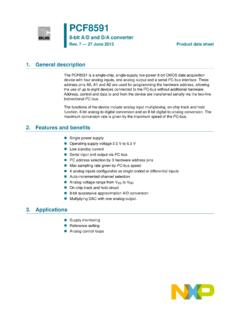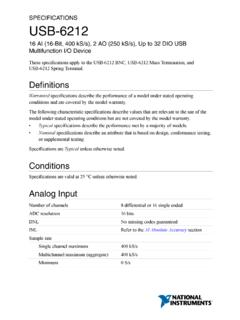Transcription of Atmel M90E26 - Microchip Technology
1 Atmel M90E26 . Single-Phase High-Performance Wide-Span Energy Metering IC. DATASHEET. FEATURES. Metering Features Metering features fully in compliance with the requirements of IEC62052-11, IEC62053-21 and IEC62053-23; applicable in class 1 or class 2 single-phase watt- hour meter or class 2 single-phase var-hour meter. Accuracy of for active energy and for reactive energy over a dynamic range of 5000:1. Temperature coefficient is 15 ppm/ (typical) for on-chip reference voltage Single-point calibration over a dynamic range of 5000:1 for active energy; no cali- bration needed for reactive energy. Energy Meter Constant doubling at low current to save verification time. Electrical parameters measurement: less than fiducial error for Vrms, Irms, mean active/ reactive/ apparent power, frequency, power factor and phase angle. Forward/ reverse active/ reactive energy with independent energy registers. Active/. reactive energy can be output by pulse or read through energy registers to adapt to different applications.
2 Programmable startup and no-load power threshold. Dedicated ADC and different gains for L line and N line current sampling circuits. Current sampled over shunt resistor or current transformer (CT); voltage sampled over resistor divider network or potential transformer (PT). Programmable L line and N line metering modes: anti-tampering mode (larger power), L line mode (fixed L line), L+N mode (applicable for single-phase three-wire system) and flexible mode (configure through register). Programmable L line and N line power difference threshold in anti-tampering mode. Other Features single power supply. Operating voltage range: ~ Metering accuracy guaranteed within ~ 5V compatible for digital input. Built-in hysteresis for power-on reset. Selectable UART interface and SPI interface (four-wire SPI interface or simplified three-wire SPI interface with fixed 24 cycles for all registers operation). Parameter diagnosis function and programmable interrupt output of the IRQ inter- rupt signal and the WarnOut signal.
3 Programmable voltage sag detection and zero-crossing output. Channel input range - Voltage channel (when gain is '1'): 120 Vrms~600mVrms. - L line current channel (when gain is '24'): 5 Vrms~25mVrms. - N line current channel (when gain is '1'): 120 Vrms~600mVrms. Programmable L line current gain: 1, 4, 8, 16, 24; Programmable N line gain: 1, 2, 4. Support L line and N line offset compensation. CF1 and CF2 output active and reactive energy pulses respectively which can be used for calibration or energy accumulation. Crystal oscillator frequency: MHz. Atmel -46002B-SE- M90E26 -Datasheet_110714. Green SSOP28 package. Operating temperature: -40 ~ +85 . APPLICATION. The M90E26 is used for active and reactive energy metering for single-phase two-wire (1P2W), single-phase three-wire (1P3W) or anti-tampering energy meters. With the measurement function, the M90E26 can also be used in power instru- ments which need to measure voltage, current, etc.
4 DESCRIPTION. The M90E26 is a high-performance wide-span energy metering chip. The ADC and DSP Technology ensure the chip's long- term stability over variations in grid and ambient environmental conditions. BLOCK DIAGRAM. MMD1 MMD0. DSP Module I1P PGA L Line Forward/Reverse Active/. X1/X4/X8/ ADC HPF1 HPF0 Reactive Power X16/X24 L Line Apparent Power I1N. L Line Irms VP. ADC HPF1 HPF0 Vrms VN. N Line Forward/Reverse Active/. I2P Reactive Power ADC NGain HPF1 HPF0. N Line Apparent Power I2N N Line Irms Vref Reference Voltage Active Reactive Power Factor/. Crystal Oscillator SPI / UART Energy Pulse Energy Pulse WarnOut/IRQ/ZX Angle/Frequency Output Output RESET Power On Reset SDO/ SDI/. OSCI OSCO CS SCLK CF1 CF2 WarnOut IRQ ZX. UTX URX. Figure-1 M90E26 Block Diagram M90E26 [DATASHEET] 2. Atmel -46002B-SE- M90E26 -Datasheet_110714. Ta bl e o f C o n t en ts 1. Application .. 2. Description .. 2. Block 2. 1 Pin Assignment .. 7. 2 Pin Description.
5 8. 3 Functional Description .. 10. Dynamic Metering Range .. 10. Startup and No-Load Power .. 10. Energy Registers .. 11. N Line Metering and Anti-Tampering .. 12. Metering Mode and L/N Line Current Sampling Gain Configuration .. 12. Anti-Tampering Mode .. 12. Measurement and Zero-Crossing .. 13. Measurement .. 13. Zero-Crossing .. 13. Calibration .. 14. Reset .. 14. 4 Interface .. 15. SPI Interface .. 15. Four-Wire Mode .. 15. Three-Wire Mode .. 16. Timeout and Protection .. 17. UART Interface .. 18. Byte Level Timing .. 18. Write Transaction .. 18. Read transaction .. 19. Checksum .. 19. WarnOut Pin for Fatal Error Warning .. 20. Low Cost Implementation in Isolation with MCU .. 20. 5 Register .. 21. Register List .. 21. Status and Special Register .. 22. Metering/ Measurement Calibration and Configuration .. 26. Metering Calibration and Configuration Register .. 26. Measurement Calibration Register .. 34. Energy Register .. 39. Measurement Register.
6 44. M90E26 [DATASHEET] 3. Atmel -46002B-SE- M90E26 -Datasheet_110714. 6 Electrical Specification .. 51. Electrical Specification .. 51. SPI Interface Timing .. 53. Power On Reset Timing .. 54. Zero-Crossing Timing .. 55. Voltage Sag Timing .. 55. Pulse Output .. 56. Absolute Maximum Rating .. 56. Ordering 57. Packaging 58. Revision History .. 59. M90E26 [DATASHEET] 4. Atmel -46002B-SE- M90E26 -Datasheet_110714. List of Tables Table-1 Pin Description .. 8. Table-2 Active Energy Metering Error .. 10. Table-3 Reactive Energy Metering Error .. 10. Table-4 Threshold Configuration for Startup and No-Load Power .. 10. Table-5 Energy Registers .. 11. Table-6 Metering Mode .. 12. Table-7 The Measurement Format .. 13. Table-8 Read / Write Result in Four-Wire Mode .. 17. Table-9 Read / Write Result in Three-Wire Mode .. 17. Table-10 Register List .. 21. Table-11 SPI Timing Specification .. 53. Table-12 Power On Reset Specification .. 54. Table-13 Zero-Crossing Specification.
7 55. Table-14 Voltage Sag Specification .. 56. M90E26 [DATASHEET] 5. Atmel -46002B-SE- M90E26 -Datasheet_110714. List of Figures Figure-1 M90E26 Block Diagram .. 2. Figure-2 Pin Assignment (Top View) .. 7. Figure-3 Read Sequence in Four-Wire Mode .. 15. Figure-4 Write Sequence in Four-Wire Mode .. 15. Figure-5 Read Sequence in Three-Wire Mode .. 16. Figure-6 Write Sequence in Three-Wire Mode .. 16. Figure-7 UART Byte Level Timing .. 18. Figure-8 Write Transaction .. 18. Figure-9 Read Transaction .. 19. Figure-10 4-Wire SPI Timing Diagram .. 53. Figure-11 3-Wire SPI Timing Diagram .. 53. Figure-12 Power On Reset Timing Diagram .. 54. Figure-13 Zero-Crossing Timing Diagram .. 55. Figure-14 Voltage Sag Timing Diagram .. 55. Figure-15 Output Pulse Width .. 56. M90E26 [DATASHEET] 6. Atmel -46002B-SE- M90E26 -Datasheet_110714. 1 PIN ASSIGNMENT. MMD1 1 28 MMD0. DGND 2 27 SDI/URX. DVDD 3 26 SDO/UTX. Reset 4 25 SCLK. AVDD 5 24 CS. AGND 6 23 OSCO. I2P 7 22 OSCI.
8 I2N 8 21 ZX. Resv_low 9 20 IRQ. I1P 10 19 CF2. I1N 11 18 CF1. USEL 12 17 WarnOut Vref 13 16 VP. AGND 14 15 VN. Figure-2 Pin Assignment (Top View). 7 M90E26 [Datasheet]. Atmel -46002B-SE- M90E26 -Datasheet_110714. 2 PIN DESCRIPTION. Table-1 Pin Description note 1. Name Pin No. I/O Type Description Reset: Reset Pin (active low). This pin should connect to ground through a F filter capacitor. In appli- Reset 4 I LVTTL. cation it can also directly connect to one output pin from microcontroller (MCU). DVDD: digital Power Supply DVDD 3 I Power This pin provides power supply to the digital part. It should be decoupled with a 10 F electrolytic capacitor and a F capacitor. DGND 2 I Power DGND: digital Ground AVDD: analog Power Supply AVDD 5 I Power This pin provides power supply to the analog part. It should be decoupled with a F capacitor. Vref: Output Pin for Reference Voltage Vref 13 O analog This pin should be decoupled with a 1 F capacitor and a 1nF capacitor.
9 AGND 6, 14 I Power AGND: analog Ground I1P: Positive Input for L Line Current I1P 10 I1N: Negative Input for L Line Current I analog I1N 11 These pins are differential inputs for L line current. Input range is 5 Vrms~25mVrms when gain is '24'. I2P: Positive Input for N Line Current I2P 7 I2N: Negative Input for N Line Current I analog I2N 8 These pins are differential inputs for N line current. Input range is 120 Vrms~600mVrms when gain is '1'. VP: Positive Input for Voltage VP 16 VN: Negative Input for Voltage I analog VN 15 These pins are differential inputs for voltage. Input range is 120 Vrms~600mVrms. USEL: UART/SPI Interface Selection High: UART interface USEL 12 I LVTTL Low: SPI interface Note: This pin should not change after reset. CS: Chip Select (Active Low) of SPI. In 4-wire SPI mode, this pin must be driven from high to low for each read/. write operation, and maintain low for the entire operation. In 3-wire SPI. CS 24 I LVTTL.
10 Mode, this pin must be low all the time. Refer to section In UART interface, this pin should be connected to VDD. SCLK: Serial Clock of SPI. This pin is used as the clock for the SPI interface. Data on SDI is shifted into the chip on the rising edge of SCLK while data on SDO is shifted out of the SCLK 25 I LVTTL. chip on the falling edge of SCLK. In UART interface, this pin should be connected to ground. M90E26 [DATASHEET] 8. Atmel -46002B-SE- M90E26 -Datasheet_110714. Table-1 Pin Description (Continued). note 1. Name Pin No. I/O Type Description SDO: Serial Data Output of SPI. This pin is used as the data output for the SPI interface. Data on this pin is shifted out of the chip on the falling edge of SCLK. SDO/UTX 26 OZ LVTTL UTX: UART Data Transmit This pin is used to transmit data for the UART interface. This pin needs to be pulled up to VDD by a 10k resistor.. Note: UART and SPI interface is selected by the USEL pin. SDI: Serial Data Input of SPI.


















